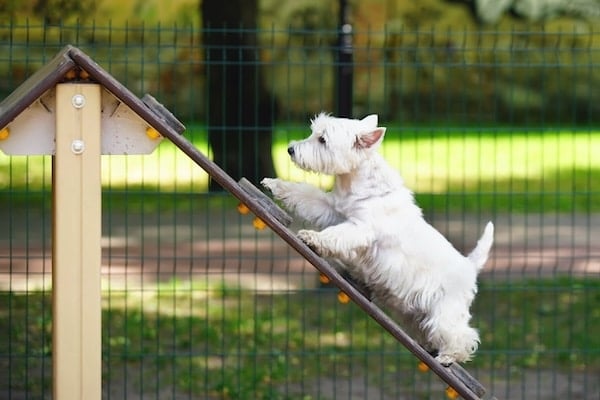- Not a substitute for professional veterinary help.
Dog parks come in all different shapes and sizes. Some are fully fenced, while others are completely open. Some parks are just a grassy field, while others may have agility equipment, dog-friendly landscaping, and even a separate area for small dogs. There are public dog parks operated by the city and private ones that require a membership or fee. But the idea is the same: a place where dogs can play, exercise, and socialize.
One question on a lot of pet parents’ minds is whether dog parks are bad for dogs. Ultimately, it depends on both the pup and the park. Pet parents have to weigh not only their dog’s training history, socialization skills, energy levels, and age, but also the park’s layout, conditions, and the other dogs and guardians present.
In this article, we’ll explore the pros and cons of dog parks, as well as the expected etiquette while you’re there. We’ll also discuss the qualities of a good or bad dog park, plus where to go instead if you find it’s not a good fit.
Dog Park Etiquette 101
Even the best-behaved dogs can have off days. To ensure your pup is feeling up to the energy of a dog park—particularly if it’s a new location—check in with them before entering. You can do this by walking the outside perimeter of the park and monitoring for signs of arousal or stress, like pinned back ears, whale eyes, hard staring, or a tucked tail.
Playing the up-down pattern game right outside the entry is also a great way to check your dog’s engagement with you. Most important is whether or not you’ll be able to recall them away from other dogs—a training skill must for dog parks.
If your dog passes with flying colors and it’s okay to go inside the park, you’ll still want to watch them vigilantly. To keep dogs safe, we recommend the following etiquette while at the dog park.
- Follow the park’s leash rules—some will be entirely off-leash, and some may only have certain off-leash areas.
- Always have your dog on a lead when entering and exiting the park, and keep the leash handy in case you need to get your dog quickly.
- Stay off your phone so you can closely monitor your dog’s interactions with other dogs.
- Pick up your dog’s poop as soon as they do their business.
- Recall your dog often and enforce play breaks to prevent overarousal.
- Avoid treats and toys to reduce the chance of resource guarding.
- Remove your dog immediately if there are any signs of aggression or behavioral escalation.
- Keep an eye on other dogs and their body language so you know when to call off your dog.
- Only bring the number of dogs that you can actively manage (likely two or three max).
- Don’t stay too long. Keep visits to 30 minutes to an hour to avoid overstimulation.
Pros and Cons of Dog Parks
When it comes to whether or not dog parks are good or bad, there is no hard line. Some dogs are better suited for the experience and will have an amazing time, while others may find the same dog park to be unpleasant or even traumatizing. As with many choices pet parents make, it comes down to knowing your dog’s abilities and fully understanding the benefits and risks involved.
Are there benefits to dog parks?
The types of dogs a veterinarian or trainer might encourage to visit a dog park include well-socialized and healthy pups that thrive on interacting and playing with other dogs. Pet parents who live in apartments or other housing with limited space might also find a dog park a good option for exercise.
The pros of taking your pup to a dog park include:
- Exercise and mental stimulation so your dog’s enrichment needs are met
- Socialization, where your dog learns how to interact with different types of dogs
- Training reinforcement, so your dog learns to listen in high-distraction environments
- Community building and getting to know your neighborhood dogs, especially during volunteer hours

Eudyptula via iStock
Are dog parks unsafe for dogs?
Dog experts don’t recommend the dog park for pups that are fearful, reactive, or show aggressive behaviors. Veterinarians are also likely to advise against going if you have a dog who is sick, injured, or isn’t fully vaccinated. You should never bring a female dog who’s in heat, and some pet parents think twice about bringing intact male dogs, whose presence can create conflict.
Dogs who lack dog social skills or pups who are more dog selective should also avoid going to the dog park. Forcing a pup who isn’t equipped to handle the experience could end up badly for all parties involved.
Some risks of dog parks include:
- Exposure to parasites and diseases, such as canine flu or Giardia
- Unpredictable or mismatched behavior from other dogs, which could result in dog fights, injuries, and long-term behavioral damage
- The opportunity to rehearse unwanted behaviors like rough play, overarousal, or resource guarding
- Crowded or noisy parks can be overwhelming for many dogs
How To Tell If a Dog Park Is Good
The dog park itself plays a significant role in determining whether it will be enjoyable for both you and your dog. When scouting for the right park, you want to make sure that:
- The park is the appropriate size. Parks that are too small and crowded increase the risk of fights or scuffles.
- There are secure fences and areas of separation. Fully enclosed spaces keep pups safe, and separate areas for dogs of different sizes can help prevent stress.
- It’s clean, and trash cans are available. A dog park littered with waste is more likely to spread diseases.
- The park has a thoughtful layout. Surfaces like grass or mulch are gentle on paws, and trees and structures provide shade.
- Other pet parents are respectful and follow dog park etiquette. Look for guardians who actively supervise their dogs, pick up their dog’s poop, and respect the park’s rules.
- Your dog has access to clean water. You can also bring your own water, as weather conditions may affect water availability.
- The park has clear, visible, and well-maintained signs. Dog parks with clear guidelines and reminders about behavior, cleanliness, and prohibited activities demonstrate that the park is well-managed.
Pro-tip: If you’re bringing a dog that isn’t yours, get permission and keep your trip short. Dog parks with a new guardian and new dogs can be a very stimulating and potentially exhausting environment.
Alternatives to Dog Parks
A dog park isn’t for every dog, and that’s okay! There are still plenty of other ways to meet your dog’s mental, physical, and social needs, such as:
- Setting up small playdates in your backyard with other dogs you know personally, and who your pup loves
- Taking your dog on a decompression walk in an open field or Sniffspot for exciting sniffs and plenty of room to romp
- Enrolling your dog in a dog sport like agility, barn hunt, or dock diving
- Sending your pup to a doggy daycare with smaller play groups and added supervision
- Playing, training, and setting up games in your backyard with your pup
- Taking your dog on a date to a pet-friendly store, brewery, or cafe
- Booking a sitter for your pup to give you a break and your dog special human hang time
Whether or not a dog park is a good fit for your dog will be something that only you and your pup can figure out together. With a bit of planning and knowing what your dog loves, you’ll find what works best!




